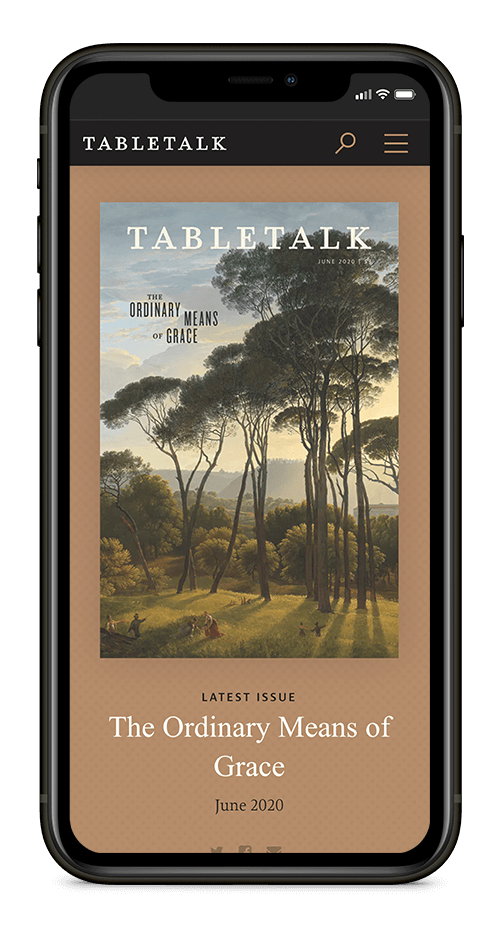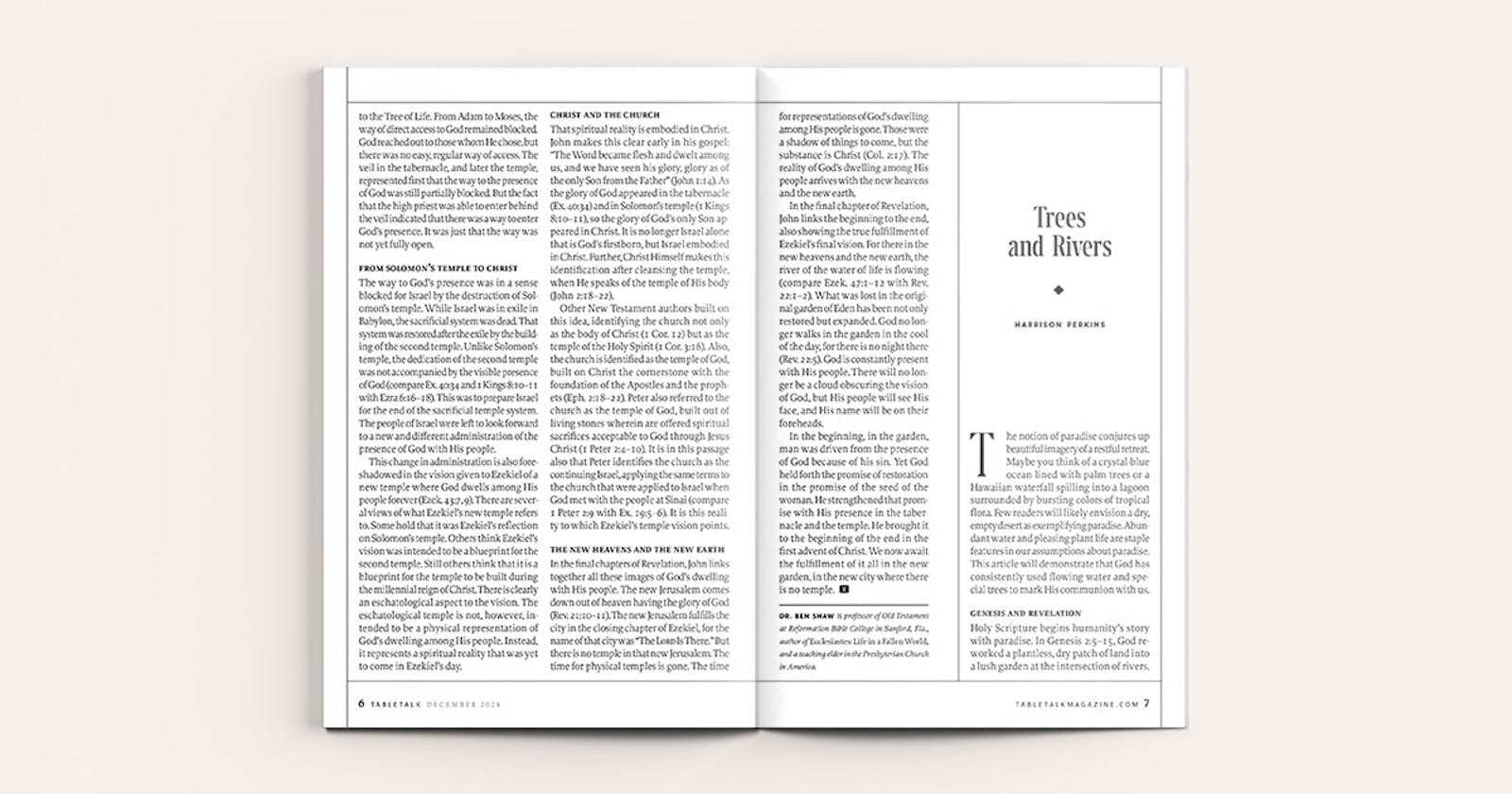
Request your free, three-month trial to Tabletalk magazine. You’ll receive the print issue monthly and gain immediate digital access to decades of archives. This trial is risk-free. No credit card required.
Try Tabletalk NowAlready receive Tabletalk magazine every month?
Verify your email address to gain unlimited access.
The notion of paradise conjures up beautiful imagery of a restful retreat. Maybe you think of a crystal-blue ocean lined with palm trees or a Hawaiian waterfall spilling into a lagoon surrounded by bursting colors of tropical flora. Few readers will likely envision a dry, empty desert as exemplifying paradise. Abundant water and pleasing plant life are staple features in our assumptions about paradise. This article will demonstrate that God has consistently used flowing water and special trees to mark His communion with us.
genesis and revelation
Holy Scripture begins humanity’s story with paradise. In Genesis 2:5–15, God reworked a plantless, dry patch of land into a lush garden at the intersection of rivers. In Eden, “no bush of the field was yet in the land and no small plant of the field had yet sprung up—for the Lord God had not caused it to rain on the land, and there was no man to work the ground.” To address the problem that this land lacked plants, water, and people, God did three things. He “planted a garden in Eden,” and then “made to spring up every tree that is pleasant to the sight and good for food,” situating this garden so that “a river flowed out of Eden to water the garden, and there it divided and became four rivers.” Having fashioned this type of environment, He placed Adam in the garden of Eden to work it and to keep it.
God cultivated this well-watered, flowering oasis as the ideal place for His first covenant servants to commune with Him. This communion happened amid special water and centered on special trees—namely, the Tree of Life and the Tree of Knowledge of Good and Evil.
Holy Scripture also concludes humanity’s story in paradise. In Revelation 22:1–5, John receives a vision of the new creation, where he sees
the river of the water of life, bright as crystal, flowing from the throne of God and of the Lamb through the middle of the street of the city; also, on either side of the river, the tree of life with its twelve kinds of fruit, yielding its fruit each month. The leaves of the tree were for the healing of the nations.
The presence of the river of the water of life and of the Tree of Life indicates how God marked the two locations of our most unimpeded communion with Him—the garden before sin entered and the new creation after Christ entirely removes sin—with trees and water.
Why would Scripture bookend the story of our communion with God with trees and rivers? Well, Revelation 22 makes sure that both have a certain description attached: life. God has marked the place of His special presence for blessing with water and trees. When we recognize how Scripture develops those themes, we see how their fulfillment in that depiction of the new creation ought to strengthen our assurance and hope.
rivers and running water
Throughout Scripture, God used water to mark His presence in special blessing with His covenant people. We already saw how that began at creation in Eden where He carefully situated the garden at the headwaters of a river filled with enough abundant water to fuel four rivers. That pattern continued whenever He instituted a new place where He would meet His people to give His presence of special blessing to us.
One easily overlooked example of how water marks God’s special presence is His meeting places with Israel in the wilderness and in the promised land. During the people’s wilderness wandering, God dwelled in the tent of meeting. As part of the tabernacle’s wider enclosure, God commanded: “You shall also make a basin of bronze, with its stand of bronze, for washing. You shall put it between the tent of meeting and the altar, and you shall put water in it” (Ex. 30:18). Just as water flowed into the garden in Eden, it marked the tabernacle’s entrance.
This feature expanded in the Jerusalem temple as the place where God’s special presence dwelled with the whole nation in the promised land. In 1 Kings 7:23–26, Solomon adds a similar feature to the temple. This time, the basin for washing is even called “the sea of cast metal” and is filled with massive amounts of water.
This basin’s presence might seem to be simply functional. After all, the Israelites needed water to facilitate washing ceremonies. The prophet Ezekiel, however, shows otherwise. In Ezekiel 47:1–12, the great abundance of waters marks God’s presence even as He will return to rescue His people. At the temple, the place of God’s special presence, “water was issuing from below the threshold of the temple” (Ezek. 47:1). God has always marked His place of blessed dwelling with His people with water.
That recurring theme brings the description of the new creation in Revelation 22 to new life. We see now how the presence of the river of the water of life is about God’s presence. It is not the river’s waters themselves that give life. God’s direct presence, now unhindered as we know Him in glory, gives life to the fullest. The flowing water just marks how that is true.
trees and the right to life
The Tree of Life in paradise encapsulates God’s offer of life to dwell in glorified communion with us. It is connected to our dwelling in God’s presence as a sacrament of our right to be there. That meaning becomes clear in its role in Genesis and Revelation.

In Genesis, God exiled Adam and Eve from the garden so that they could not eat from the Tree of Life. After Adam sinned, the Lord acted to block humanity from the Tree of Life:
“Behold, the man has become like one of us in knowing good and evil. Now, lest he reach out his hand and take also of the tree of life and eat, and live forever—” therefore the Lord God sent him out from the garden of Eden to work the ground from which he was taken. (Gen. 3:22–23)
God marked His curse on sin by blocking access to this special tree.
By contrast, in Revelation 22 those in Christ receive renewed access to this very tree. The tree is present as far more than just a nice piece of landscaping. It serves to mark how believers have the right to be in the new- creation kingdom: “Blessed are those who wash their robes, so that they may have the right to the tree of life and that they may enter the city by the gates” (Rev. 22:14, emphasis added). When we have clean robes as those who have been cleansed by Christ through the forgiveness of sin, we receive the right to food from this Tree of Life. Moreover, it represents our right to enter the everlasting city’s gates. In other words, eating from the Tree of Life is a mark of how “our citizenship is in heaven” (Phil. 3:20) and that we belong in the kingdom of glory because we belong to Christ by faith.
Although Adam’s sin closed the way to the Tree of Life at creation, the last Adam—Jesus Christ—grants all its rights and privileges to those whom He has redeemed. Although God used this tree as part of His curse on Adam by blocking access to it, now it signifies salvation, since its leaves are “for the healing of the nations” (Rev. 22:2). What once marked our shame as God sent us away from it has become a mark of our restoration as God welcomes His people back to it to know His blessed presence in everlasting life.
the church’s present experience
How should we think about rivers and trees during our experience as the church waiting for Christ to return to bring His kingdom of glory? Although it is less obvious, God still marks His people with these same features.
All who belong to the church are sealed with the waters of baptism. Just as water encircled the place of God’s special presence in blessing at creation and with Israel, so too the church is bordered by baptismal waters. In this age, abundant water still marks God’s temple as He receives us into the church by baptism (1 Cor. 3:16).
The church is also marked as God’s people in relation to a tree. Our Savior endured our curse, which sent us away from the Tree of Life, by being hung on the tree of the cross (Gal. 3:13). Although that tree is not exactly present in our midst, Christ has left us a meal to eat as the results of that tree. He left us the Lord’s Supper so that we might eat the food of the cross. By this meal, we know that we have a place at the table in the everlasting city to eat from the Tree of Life. Best of all, at that table, we will see Jesus face-to-face eating with us.
